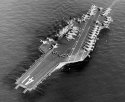Thanks for that explanation.

I realize that design is from you book...Maybe I'm to stead fast in my thinking on a Cv design..I of course prefere the design of a USN CV..My preference!
And of course my favorite design The USS Midway CV-41. This picture is from the '70's.
Popeye, justifiably so!
The US super-carrier, catapault take-off and arrested landing design is the most proven and worthy design available for nations that can afford that large a design and can afford the size of air wing that makes that design so formidable. There is none better.
But for a country that may be seeking to emulate the catapault take-off and arrested landing functionality for less cost and with a smaller air wing...this is simply a possibility...and a possibility from a fictional novel at that. That's all.
I have had people ask me (on this forum and elsewhere to flesh out the represnetation is all and thought I would post it here.
1. It is easier to actually turn into the direction the wind is going. A ship can change direction you know, it is not a static airfield where this would make more sense.
Turning into the wind works fine for any design as well...this design just lends some additional functionality in that regard while allowing the modular conversion from existing container ship designs to be more easily and quickly accomplished...which is the main point.
2. If you want to modify a current container ship, go along the lines of the World War II concept, the Escort Aircraft Carrier (CVE). The concept has already been tried before, and it worked fairly well for the situation at hand.
Well a modern CVE is exactly the concept here. This is a smaller, less expensive, more quickly produced design than current full size, catapault take-off and arrested landing carriers. But, it has the advantage of being able to add many of the same capabilities and features of the conventional carrier, in a smaller package.
The World War II CVE was not made from container ships like what we see today, because they did not exist. They were made from either military conversions, or from commercial merchant ships. To take those exact designs and try to apply them today would not work as well today due to the ordinance, fuel, and capacities required to maintain air ops with modern aircraft in a modern threat environemnt. But this type of conversion from a modern container ship, in concept is the same type of thing and could fulfill that role in a modern environment.
Finally, in the end, this design is simply put forth in a fictional book. Meant to lend reality to the story about perhaps what might be possible...but not reality, and not an actual design currently under consideration by any actual navy that I know of.
 I took a little holiday from the forum..I'm back.
I took a little holiday from the forum..I'm back.
